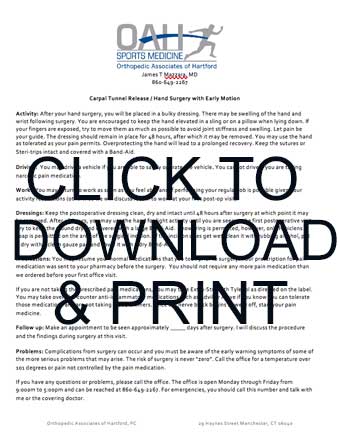Activity: Today, many total knee replacements can be performed on an outpatient basis. After
your knee replacement, you should be given crutches or a walker. These should be used only as
long as you feel the additional support is necessary. You may put your foot on the ground for
balance, but you may put full weight on the operative leg immediately after surgery and walk as
normally as possible. You are encouraged to bend and straighten your knee as much as possible
postoperatively to avoid stiffness. Elevation of the leg is important for the first few days after the
surgery as it helps to reduce the leg swelling. After 1-2 days, if your knee is feeling good, you may
increase your activity level gradually.
Use ice packs to the knee for the first 24-48 hours after surgery. Apply the ice as frequently as
needed after surgery. After 24 hours, you may use the ice packs two or more times a day for 20
minutes at a time, if desired for comfort.
Dressings: The post op dressing should remain in place until you are seen in the office where we
will remove the dressing. It is a waterproof dressing and you may shower immediately after
surgery if the dressing remains intact. It is normal to have small amounts of drainage of blood on
the dressing in the day after surgery. If there appears to be a great deal of bleeding under the
surgical dressing, call or come into the office so we can evaluate this. Once the dressing is
removed, you may shower as long as you use Hibiclens soap to clean the entire leg.
Driving: Your ability to drive depends on which knee was replaced. It usually safer to wait 2-4
weeks until he can safely drive. We can discuss this in the office during your first postop visit. You
cannot drive if you are taking narcotic pain medication.
Work: You may return to work as soon as you feel able and performing your regular job is possible
given your activity restrictions. It will take longer to return to a physically demanding job than it
will to a more sedentary occupation. How long it takes you to return to work is highly variable.
The time to return to work can be as short as 2 weeks or as long as 2-3 months.
Medications: You may resume your normal medications that you took prior to surgery. Your
prescription for pain medication was sent to your pharmacy before the surgery. You should not
require any more pain medication than we ordered before your first office visit.
If you are not taking the prescribed pain medications, you may take Extra-Strength Tylenol as
directed on the label. You may take over-the-counter anti-inflammatory medications such as Advil
or Aleve if you know you can tolerate those medications and are not taking blood thinners. Once
the nerve block begins to wear off, start your pain medicine.
If you are taking blood thinners before surgery, we need to be aware of these medications and you
can likely resume those medications within 24 hours of surgery. Some patients may also be asked
to take additional occasion such as anti-inflammatories and possibly aspirin. Patient is at high risk
for blood clots in the leg or embolism may be required to utilize injectable blood thinners. This will
be discussed and decided before surgery depending on your individual risk for blood clots and
embolism.
Unless you are allergic, take one aspirin 81mg twice per day to reduce the chances of blood
clots. Blood clots may occur after any surgery or injury to the leg and may be associated with
complaints of calf pain, calf cramping, pain in back of the knee, chest pain or shortness of breath.
Follow up: Make an appointment to be seen the first or second office day after surgery. I will
discuss the procedure and the findings during surgery at this visit.
You should have your physical therapy already scheduled to begin the day after surgery.
At the first postoperative visit we will also discuss physical therapy. We generally prefer physical
therapy be performed and an outpatient physical therapy clinic however in some circumstances
we may permit patients to perform therapy at home.
Problems: Complications from knee surgery can occur and you must be aware of the early
warning symptoms of some of the more serious problems that may arise. The risk of surgery is
never “zero”. Before surgery and we generally discussed risks of surgery which can include but are
not limited to nerve damage, bleeding, infection, blood clots, embolism, laxity, stiffness,
continuing pain and the remote possibility of heart attack, stroke, death.
In the immediate postop, complications may also include fevers, urinary retention, bleeding and
blood clots among other problems. Call the office for a temperature over 101 degrees, pain not
controlled by the pain medication, or drainage from the incision that lasts more than 24 hours or
calf pain, chest pain, or shortness of breath.
